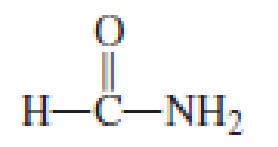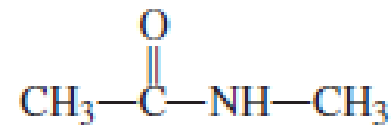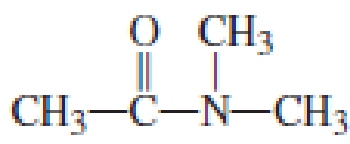
Organic And Biological Chemistry
7th Edition
ISBN: 9781305081079
Author: STOKER, H. Stephen (howard Stephen)
Publisher: Cengage Learning,
expand_more
expand_more
format_list_bulleted
Concept explainers
Textbook Question
Chapter 6, Problem 6.146EP
Draw the structure of the nitrogen-containing compound produced when each of the amides in Problem 17-140 is hydrolyzed with NaOH present (basic conditions).




Expert Solution & Answer
Trending nowThis is a popular solution!

Students have asked these similar questions
Indicate the functions that salt bridges have in batteries.
In the battery:Pt | H2 (g) | H+ (aq) | Fe2+ (aq) | FeIndicate the cathode and anode.
Write the equations that occur when the electrode Pb (s) | PbI2 (s) | KI (ac) in a galvanic cell. a) It functions as a positive electrode b) It functions as a negative electrode c) What is the ion with respect to which this electrode is reversible?
Chapter 6 Solutions
Organic And Biological Chemistry
Ch. 6.1 - Prob. 1QQCh. 6.1 - Prob. 2QQCh. 6.2 - Prob. 1QQCh. 6.2 - Prob. 2QQCh. 6.2 - Prob. 3QQCh. 6.2 - Prob. 4QQCh. 6.3 - Prob. 1QQCh. 6.3 - Prob. 2QQCh. 6.3 - Prob. 3QQCh. 6.3 - Prob. 4QQ
Ch. 6.4 - Prob. 1QQCh. 6.4 - Prob. 2QQCh. 6.5 - Prob. 1QQCh. 6.5 - Prob. 2QQCh. 6.5 - Prob. 3QQCh. 6.6 - Prob. 1QQCh. 6.6 - Prob. 2QQCh. 6.6 - Prob. 3QQCh. 6.7 - Prob. 1QQCh. 6.7 - Prob. 2QQCh. 6.7 - Prob. 3QQCh. 6.8 - Prob. 1QQCh. 6.8 - Prob. 2QQCh. 6.8 - Prob. 3QQCh. 6.8 - Prob. 4QQCh. 6.9 - Prob. 1QQCh. 6.9 - Prob. 2QQCh. 6.10 - Prob. 1QQCh. 6.10 - Prob. 2QQCh. 6.10 - Prob. 3QQCh. 6.10 - Prob. 4QQCh. 6.11 - Prob. 1QQCh. 6.11 - Prob. 2QQCh. 6.11 - Prob. 3QQCh. 6.12 - Prob. 1QQCh. 6.12 - Prob. 2QQCh. 6.12 - Prob. 3QQCh. 6.12 - Prob. 4QQCh. 6.13 - Prob. 1QQCh. 6.13 - Prob. 2QQCh. 6.13 - Prob. 3QQCh. 6.13 - Prob. 4QQCh. 6.14 - Prob. 1QQCh. 6.14 - Prob. 2QQCh. 6.14 - Prob. 3QQCh. 6.15 - Prob. 1QQCh. 6.15 - Prob. 2QQCh. 6.16 - Prob. 1QQCh. 6.16 - Prob. 2QQCh. 6.16 - Prob. 3QQCh. 6.17 - Prob. 1QQCh. 6.17 - Prob. 2QQCh. 6.17 - Prob. 3QQCh. 6.18 - Prob. 1QQCh. 6.18 - Prob. 2QQCh. 6.18 - Prob. 3QQCh. 6.19 - Prob. 1QQCh. 6.19 - Prob. 2QQCh. 6.19 - Prob. 3QQCh. 6.19 - Prob. 4QQCh. 6 - Prob. 6.1EPCh. 6 - Prob. 6.2EPCh. 6 - Prob. 6.3EPCh. 6 - Prob. 6.4EPCh. 6 - Prob. 6.5EPCh. 6 - Prob. 6.6EPCh. 6 - Prob. 6.7EPCh. 6 - Indicate whether or not each of the following...Ch. 6 - Indicate whether each of the compounds in Problem...Ch. 6 - Prob. 6.10EPCh. 6 - Prob. 6.11EPCh. 6 - Prob. 6.12EPCh. 6 - Prob. 6.13EPCh. 6 - Prob. 6.14EPCh. 6 - Prob. 6.15EPCh. 6 - Prob. 6.16EPCh. 6 - Prob. 6.17EPCh. 6 - Assign an IUPAC name to each of the following...Ch. 6 - Prob. 6.19EPCh. 6 - Prob. 6.20EPCh. 6 - Prob. 6.21EPCh. 6 - Prob. 6.22EPCh. 6 - Prob. 6.23EPCh. 6 - Prob. 6.24EPCh. 6 - Prob. 6.25EPCh. 6 - Classify each of the following compounds as a 1...Ch. 6 - Prob. 6.27EPCh. 6 - Prob. 6.28EPCh. 6 - Prob. 6.29EPCh. 6 - Prob. 6.30EPCh. 6 - Prob. 6.31EPCh. 6 - Prob. 6.32EPCh. 6 - Prob. 6.33EPCh. 6 - Prob. 6.34EPCh. 6 - Determine the maximum number of hydrogen bonds...Ch. 6 - Prob. 6.36EPCh. 6 - Although they have similar molecular masses (73...Ch. 6 - Prob. 6.38EPCh. 6 - Prob. 6.39EPCh. 6 - Prob. 6.40EPCh. 6 - Show the structures of the missing substance(s) in...Ch. 6 - Prob. 6.42EPCh. 6 - Prob. 6.43EPCh. 6 - Prob. 6.44EPCh. 6 - Prob. 6.45EPCh. 6 - Prob. 6.46EPCh. 6 - Prob. 6.47EPCh. 6 - Prob. 6.48EPCh. 6 - Prob. 6.49EPCh. 6 - Prob. 6.50EPCh. 6 - Prob. 6.51EPCh. 6 - Prob. 6.52EPCh. 6 - Prob. 6.53EPCh. 6 - Prob. 6.54EPCh. 6 - Prob. 6.55EPCh. 6 - Prob. 6.56EPCh. 6 - Prob. 6.57EPCh. 6 - Prob. 6.58EPCh. 6 - Prob. 6.59EPCh. 6 - Prob. 6.60EPCh. 6 - Prob. 6.61EPCh. 6 - Prob. 6.62EPCh. 6 - Prob. 6.63EPCh. 6 - Prob. 6.64EPCh. 6 - Prob. 6.65EPCh. 6 - Prob. 6.66EPCh. 6 - Prob. 6.67EPCh. 6 - Prob. 6.68EPCh. 6 - Prob. 6.69EPCh. 6 - Prob. 6.70EPCh. 6 - Prob. 6.71EPCh. 6 - Prob. 6.72EPCh. 6 - Prob. 6.73EPCh. 6 - Prob. 6.74EPCh. 6 - Name each of the salts in Problem 17-71. a....Ch. 6 - Prob. 6.76EPCh. 6 - Indicate whether or not each of the following...Ch. 6 - Prob. 6.78EPCh. 6 - Prob. 6.79EPCh. 6 - Prob. 6.80EPCh. 6 - Prob. 6.81EPCh. 6 - Prob. 6.82EPCh. 6 - Prob. 6.83EPCh. 6 - Prob. 6.84EPCh. 6 - Prob. 6.85EPCh. 6 - Prob. 6.86EPCh. 6 - Prob. 6.87EPCh. 6 - Prob. 6.88EPCh. 6 - Prob. 6.89EPCh. 6 - Prob. 6.90EPCh. 6 - Prob. 6.91EPCh. 6 - Indicate whether each of the following statements...Ch. 6 - Prob. 6.93EPCh. 6 - Prob. 6.94EPCh. 6 - Prob. 6.95EPCh. 6 - Prob. 6.96EPCh. 6 - Prob. 6.97EPCh. 6 - Prob. 6.98EPCh. 6 - Indicate whether or not each of the following...Ch. 6 - Prob. 6.100EPCh. 6 - Classify each of the following amides as...Ch. 6 - Classify each of the following amides as...Ch. 6 - Prob. 6.103EPCh. 6 - Prob. 6.104EPCh. 6 - Prob. 6.105EPCh. 6 - Prob. 6.106EPCh. 6 - Prob. 6.107EPCh. 6 - Assign an IUPAC name to each of the following...Ch. 6 - Prob. 6.109EPCh. 6 - Prob. 6.110EPCh. 6 - Prob. 6.111EPCh. 6 - Prob. 6.112EPCh. 6 - Prob. 6.113EPCh. 6 - Prob. 6.114EPCh. 6 - Prob. 6.115EPCh. 6 - Prob. 6.116EPCh. 6 - Prob. 6.117EPCh. 6 - Prob. 6.118EPCh. 6 - Prob. 6.119EPCh. 6 - Prob. 6.120EPCh. 6 - Prob. 6.121EPCh. 6 - Prob. 6.122EPCh. 6 - Prob. 6.123EPCh. 6 - Prob. 6.124EPCh. 6 - Prob. 6.125EPCh. 6 - Prob. 6.126EPCh. 6 - Prob. 6.127EPCh. 6 - Prob. 6.128EPCh. 6 - Prob. 6.129EPCh. 6 - Prob. 6.130EPCh. 6 - Prob. 6.131EPCh. 6 - Prob. 6.132EPCh. 6 - Prob. 6.133EPCh. 6 - Prob. 6.134EPCh. 6 - Prob. 6.135EPCh. 6 - Prob. 6.136EPCh. 6 - Prob. 6.137EPCh. 6 - Prob. 6.138EPCh. 6 - Prob. 6.139EPCh. 6 - Prob. 6.140EPCh. 6 - Prob. 6.141EPCh. 6 - Prob. 6.142EPCh. 6 - Prob. 6.143EPCh. 6 - Prob. 6.144EPCh. 6 - Prob. 6.145EPCh. 6 - Draw the structure of the nitrogen-containing...Ch. 6 - Prob. 6.147EPCh. 6 - Prob. 6.148EPCh. 6 - Prob. 6.149EPCh. 6 - Prob. 6.150EPCh. 6 - Prob. 6.151EPCh. 6 - Prob. 6.152EPCh. 6 - Prob. 6.153EPCh. 6 - Prob. 6.154EP
Knowledge Booster
Learn more about
Need a deep-dive on the concept behind this application? Look no further. Learn more about this topic, chemistry and related others by exploring similar questions and additional content below.Similar questions
- State the formula to find the electromotive force of a battery as a function of the potential of the anode and the cathode.arrow_forwardWhy are normal electrode potentials also called relative electrode potentials?arrow_forwardEasily differentiate between electrochemical potential and Galvani potential.arrow_forward
- Construct a molecular orbital diagram for carbon monoxide. Identify the relevant point group,include all of the appropriate symmetry labels and pictures, and fill in the electrons. Make sure toaccount for the difference in electronegativity between C and O. Hint: CO is substantiallyisoelectronic to N2. (PLEASE DRAW THE ENTIRE MO DIAGRAM!!!)arrow_forwardplease help with hwarrow_forwardhelp me solve this hwarrow_forward
arrow_back_ios
SEE MORE QUESTIONS
arrow_forward_ios
Recommended textbooks for you
 General, Organic, and Biological ChemistryChemistryISBN:9781285853918Author:H. Stephen StokerPublisher:Cengage Learning
General, Organic, and Biological ChemistryChemistryISBN:9781285853918Author:H. Stephen StokerPublisher:Cengage Learning Organic And Biological ChemistryChemistryISBN:9781305081079Author:STOKER, H. Stephen (howard Stephen)Publisher:Cengage Learning,
Organic And Biological ChemistryChemistryISBN:9781305081079Author:STOKER, H. Stephen (howard Stephen)Publisher:Cengage Learning,

General, Organic, and Biological Chemistry
Chemistry
ISBN:9781285853918
Author:H. Stephen Stoker
Publisher:Cengage Learning

Organic And Biological Chemistry
Chemistry
ISBN:9781305081079
Author:STOKER, H. Stephen (howard Stephen)
Publisher:Cengage Learning,
Nomenclature: Crash Course Chemistry #44; Author: CrashCourse;https://www.youtube.com/watch?v=U7wavimfNFE;License: Standard YouTube License, CC-BY